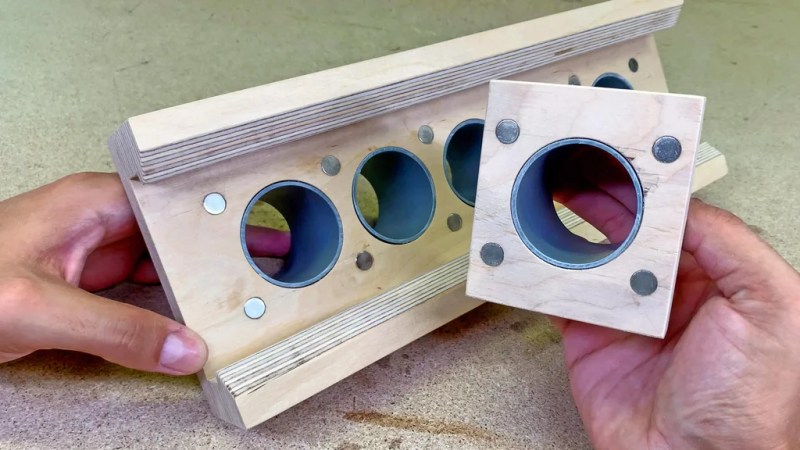Let’s say you’re doing lots of woodwork now, and you’ve expanded your workshop with a few big tools. You’re probably noticing the sawdust piling up awfully quick. It would be ideal to have some kind of collection system, but you don’t want to buy a shop vac for every tool. This simple manifold from [Well Done Tips] is the perfect solution for you.
It’s a basic rig at heart, but nonetheless a useful one. It consists of a plywood frame with a shuttle that slides back and forth. The suction hose of your shop vac attaches to the shuttle. Meanwhile, the frame has a series of pipes leading to the dust extraction ports of your various tools around the shop. When you power up a tool, simply slide the manifold to the right position, and you’re good to go. Magnets will hold it in place so it doesn’t get jostled around while you work.
It’s a much cheaper solution than buying a huge dust extraction system that can draw from all your tools at once. If you’re just one person, that’s overkill anyway. This solution is just about sized perfectly for small home operators. Give it a go if you’re tired of sweeping up the mess and coughing your lungs out on the regular. Video after the break.

















This is brilliant
My basement workspace combines pottery (clay and glaze dust – all heavy in silica dust), decorative glass (again, silica with associated grinders), laser engraver and a large supply of either tools or products which result in potentially hazardous dust. Luckily, there is a whole-house vacuum system which I have tapped-into with a similar manifold. The vacuum discharges outdoors, since this type of dust can pass thru HEPA filters. Further, I’ve added a large DIY “whole basement” air filter (only HEPA level). The goal is to protect both myself and my wife & cats. So, a great article on dust management.
Doesn’t the outdoor exhaust also contain the hazardous dust so you can spread it outdoors and affect everything out there including wife or cats?
The magnets are kinda genius.
That’s going to suck a lot. :)
I love the idea… but why not just wye them all together, and put a little blast-gate next to each machine.
Open the gate, use the tool, close the gate.
You get reduced suction if you forget a gate open, but you no longer need to visit the manifold every time you switch tools. (Bonus points if you electronically actuate the blast gate to auto-open when the tool starts)
For me that would be a non starter, as it doesn’t suit my space at all. Where this sort of concept is a compact solution that can be worked in more easily – mount the manifold directly to the tool or tool cart and all you need to do to use them is get them out and go find the shopvac from whatever location its got to now for that small bundle of tools.
A gated system really makes sense when you have a big static vacuum source and a collection of tools that never have to move and so you can run the extraction hose to conveniently. But in the smaller shop where that same workspace will be used on a wide variety of tools and you are constantly having to juggle a system like this makes more sense.
With a big wye setup, dust can accumulate in eddy currents in the unused branches, only being blasted out when you select the given branch. Sometimes if it’s had a while to build up, it won’t clear completely.
This avoids that by making a simple straight-line path to the branch of interest.
Also, this thing could easily leak less than a bunch of closed blast gates, which might help a lot if you only have a shopvac
This seems like a very backwards way to do it. Why not just put a flap valve at each tool? You simply open the valve at the tool you are using? Isn’t this how it has always been done with limited capacity shop dust extraction systems???
This design is simpler and robust, multiplying flap valves is multiplying the points of failure
Excellent problem-solving, design, and build.
hmm, with the magnets already there couldn’t you
1. recess the 5 static tubes – lets say – 2mm
2. install an 1mm thick o-ring in each (glue it?)
3. and let the single moveable tube protrude 1,5mm
to get a better seal?
You’d need to pull the slider out a bit but the magnets would pull the protruding tube against the o-ring for a better seal…
Maybe silicon/caulk(?) instead of o-rings?
There is no need for a better seal.
As long as the plates are flat they will such to each other when the vacuum is turned on. The leakage is easily negligible.
In this video though, the magnets seem to stick out a bit in this video, which is not good, as this will rub off the nickel plating of the magnets, and then they will oxidize quite easily.
I quite like this idea of a single slider compared with all separate valves.
It also invites for further automation. It’s quite easy for example to add a single (stepper) motor with either a piece of all thread or a timing belt to move the valve hose.
That would not only make it quicker to operate (detection could be with a multiple outlet master / slave switch), but because it does not have to be accessible you can tug it away in some difficult to access corner and reclaim the space under your workbench for something more usable.
You can also do this with a cord and a pulley.